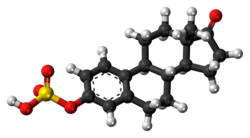 | |
 | |
| Clinical data | |
|---|---|
| Other names | E1S; Oestrone sulfate; Estrone 3-sulfate; Estra-1,3,5(10)-trien-17-one 3-sulfate |
| Routes of administration | By mouth, others [1] [2] [3] |
| Drug class | Estrogen; Estrogen ester |
| Pharmacokinetic data | |
| Protein binding | 90%, to albumin, and not to SHBG [4] |
| Metabolism | Desulfation (via STS ) [5] |
| Metabolites | • Estrone [1] • Estradiol [1] |
| Elimination half-life | 12 hours [6] |
| Identifiers | |
| |
| CAS Number |
|
| PubChem CID | |
| IUPHAR/BPS | |
| DrugBank | |
| ChemSpider | |
| UNII | |
| ChEBI | |
| ChEMBL | |
| Chemical and physical data | |
| Formula | C18H22O5S |
| Molar mass | 350.43 g·mol−1 |
| 3D model (JSmol) | |
| |
| |
| (verify) | |
Estrone sulfate (E1S) is an estrogen medication and naturally occurring steroid hormone. [1] It is used in menopausal hormone therapy among other indications. [1] [2] As the sodium salt (sodium estrone sulfate), it is the major estrogen component of conjugated estrogens (Premarin) and esterified estrogens (Estratab, Menest). [1] [3] In addition, E1S is used on its own as the piperazine salt estropipate (piperazine estrone sulfate; Ogen). [1] [3] The compound also occurs as a major and important metabolite of estradiol and estrone. [1] E1S is most commonly taken by mouth, but in the form of Premarin can also be taken by parenteral routes such as transdermal, vaginal, and injection. [1] [2]
